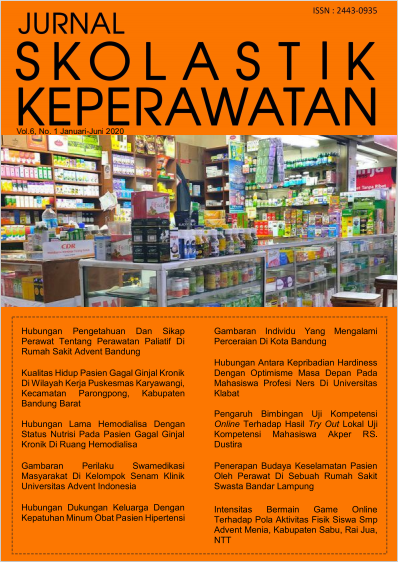HUBUNGAN DUKUNGAN KELUARGA DENGAN KEPATUHAN MINUM OBAT PASIEN HIPERTENSI
Keywords:
Dukungan keluarga, Hipertensi, Kepatuhan minum obatAbstract
ABSTRACT
Introduction: Hypertension requires lifelong treatment. One influence of the successful treatment of hypertensive patients is adherence to taking drugs through family support roles. Purpose: This study identified the relationship between family support and adherence to taking medication for hypertensive patients at the Airmadidi Health Center in North Minahasa Regency. Method: This study was an observational analytic with cross-sectional approach. The sampling technique used was purposive sampling with a sample of 127 respondents diagnosed with hypertension. Results: Dominant family support (84.3%) was included in the low category, and dominant medication adherence (65.4%) was included in the low category. There is a significant relationship between family support and medication adherence to hypertensive patients (p value 0.016), but the correlation coefficient is weak (r = -0.213) with a negative relationship direction. Discussion: Communities including families of hypertensive patients are expected to take part in improving compliance with taking medication for hypertensive patients, and for hypertensive patients must be more obedient in taking drugs.
Keywords: Family Support, Hypertension, Adherence, Taking Medication.
Downloads
References
American Heart Association. (2018). High blood pressure. Retrieved from American Heart Association Web Site: http://www.heart.org/en/health-topics/high-blood-pressure
DiGiulio, M., Jackson, D., & Keogh, J. (2014). Keperawatan medikal bedah. Yogyakarta: Rapha Publishing.
Efendi, H., & Larasati, T. (2017). Dukungan keluarga dalam manajemen penyakit hipertensi. Journal Majority, VI, 1-7.
Evadewi, P., & Sukmayanti, L. (2013). Kepatuhan mengonsumsi obat pasien hipertensi di Denpasar ditinjau dari kepribadian tipe A dan tipe B. Jurnal Psikologi Udayana, 1, 32-42.
Kaukabie, A. (2013). Penerapan fungsi-fungsi peran dalam komunikasi keluarga yang memiliki individu penyandang autisme. Journal Universitas Airlangga, 2, 1-15.
Kementerian Kesehatan Republik Indonesia. (2013). Pedoman teknis penemuandan tatalaksana penyakit hipertensi. Diakses dari KemKes Web Site: http;//www.p2ptm.go.id/uploads/2016/10/Pedoman-Teknis-Penemuan-dan-Tatalaksana-Hipertensi.pdf
Kementerian Kesehatan Republik Indonesia. (2013). Riset kesehatan dasar. Diakses dari Departemen Kesehatan Web Site:http://www.depkes.go.id/resources/download/general/hasil%20riskesdas%202013.pdf
Kementerian Kesehatan Republik Indonesia. (2018). Hipertensi membunuh diam-diam, ketahui tekanan darah anda.Diakses dari Departemen Kesehatan Web Site:http://www.depkes.go.id/article/print/18051600004/hipertensi-membunuh-diam-diam-ketahui-tekanan-darah-anda.html
Meteng, R., Undap, V., & Kabo, D. (2016). Hubungan dukungan keluarga dengan kepatuhan minum obat pada penderita hipertensi di Markas Komando Lantamal VIII Manado. E-Jurnal Sariputra, 3.
Nurdjanah, S., Sarwinanti, & Kustiningsih. (2015). Hubungan dukungan keluarga dengan kepatuhan pelaksanaan program kemoterapi pada klien kanker payudara di RSUP Dr. Sardjito Yogyakarta. Jurnal Aisyiyah Yogyakarta, 1-14.
Osamor, P. (2015). Social support and management of hypertenson in South Nigeria. Cardiovascular Journal of Africa, 29-33.
Puspita, E. (2016). Faktor-faktor yang berhubungan dengan kepatuhan penderita hipertensi dalam menjalani pengobatan(skripsi terpublikasi). Diakses dari UNNES Web Site: http;//www.lib.unnes.ac.id/23134/1/6411411036.pdfSetiadi. (2013). Konsep dan praktik riset keperawatan. Jakarta: Graha Ilmu.
Sumantra, I., Kumaat, L., & Bawotong, J. (2017). Hubungan dukungan informatif dan emosional keluarga dengan kepatuhan minum obat pada lansia hipertensi di Puskesmas Ranomuut Kota Manado.E-jurnal Keperawatan, 5, 1-6.
Susanto, Y. (2015). Hubungan dukungan keluarga dengan kepatuhan minum obat pasien hipertensi lansia di wilayah kerja Puskesmas Sungai Cuka Kabupaten Tanah Laut. Jurnal Ilmiah Manuntung, I, 62-67.
WHO. (2010). Adherence to long-term therapies: evidence for action. Diakses dari WHO Web Site: http://www.who.int/chp/knowledge/publications/adherence_report/en/index.html
WHO. (2014). Global status report on noncommunicable diseases. Diakses dari WHO Web Site: http://www.apps.who.int/iris/bitstream/handle/10665/148114/9789241564854_eng.pdf;jsessionid=281de69df7136ac79a110fd569166f9c?sequence=1
World Health Organization. (2013). A global brief on hypertension, silent killer, global public health crisis. Diakses dari WHO Web Site: http://www.apps.who.int/iris/bitstream/handle/10665/79059/who_dco_whd_2013_eng.pdf?sequence=1
World Health Organization. (2018). 10 facts on noncommunicable diseases. Diakses dari WHO Web Site: http://www.who.int/features/factfiles/noncommunicable_diseases/en/
Yudanari, Y. (2015). Kepatuhan pengobatan pada penderita hipertensi. MEDISINA Jurnal Keperawatan dan Kesehatan AKPER YPIB Majalengka, 1, 1-8.
Downloads
Published
How to Cite
Issue
Section
License
Copyright (c) 2021 I Gede Purnawinadi, Irene Jessica Lintang

This work is licensed under a Creative Commons Attribution-NonCommercial-ShareAlike 4.0 International License.
Authors who publish with this journal agree to the following terms:
- Authors retain copyright and grant the journal right of first publication with the work simultaneously licensed under a Creative Commons Attribution-NonCommercial-ShareAlike 4.0 International (CC BY-NC-SA 4.0) that allows others to share the work with an acknowledgment of the work's authorship and initial publication in this journal.
- Authors are able to enter into separate, additional contractual arrangements for the non-exclusive distribution of the journal's published version of the work (e.g., post it to an institutional repository or publish it in a book), with an acknowledgment of its initial publication in this journal.
- Authors are permitted and encouraged to post their work online (e.g., in institutional repositories or on their website) prior to and during the submission process, as it can lead to productive exchanges, as well as earlier and greater citation of published work (See The Effect of Open Access).









